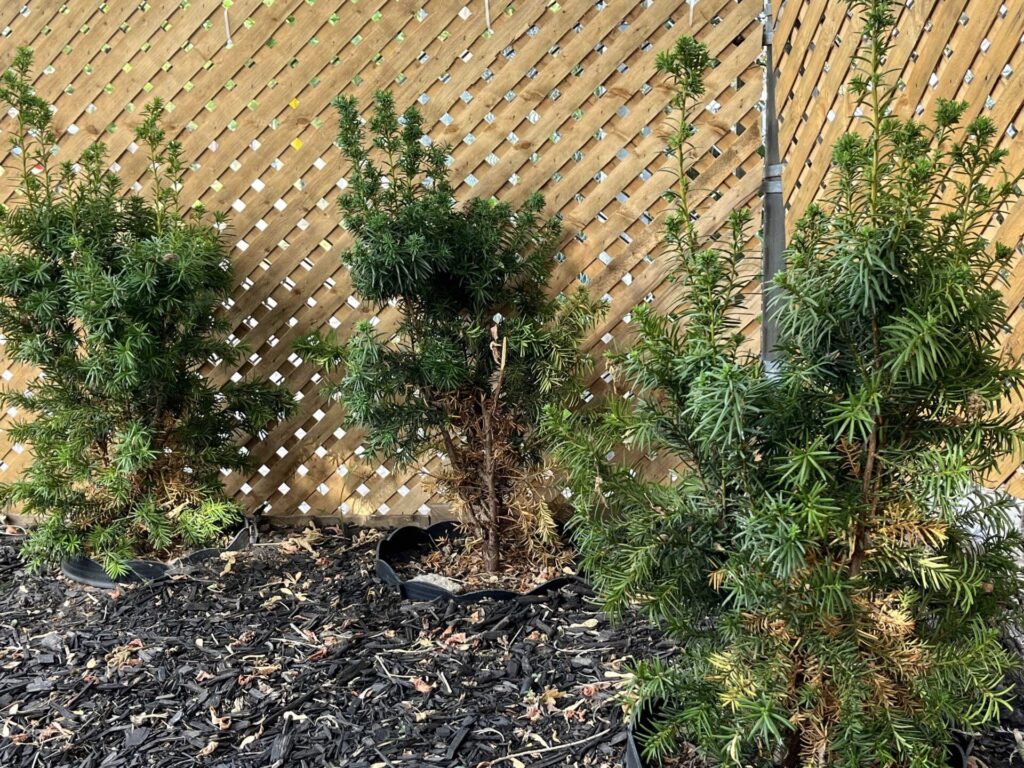
Hi – I planted these 3 Hick’s Yews last spring. The middle one started yellowing late winter. I cut off the part that was brown. The other 2 started yellowing early summer. I am in Toronto. The plants get about 4 hours of sun a day. Please advise on care instructions to save the yews. Photo is attached. Thanks very much.
Thanks for the question about your three Hicks yews (Taxus x media ‘Hicksii’).
The Hicks yew is a very hardy, versatile and low maintenance shrub suitable for most growing conditions and a valuable addition to many landscapes. The genus to which it belongs (Taxus x media) is a cross between the ornamental English yew and the hardy Japanese yew. It has few pests or diseases and is resistant to urban pollution. It tolerates a wide range of soil types, including poor soils – although it will do best if it gets sufficient organic matter. In Canada, it is hardy to about Zone 4, so therefore fully hardy in Toronto. (You don’t say where you live, but I am assuming Toronto or elsewhere in southern Ontario). A Hicks yew will grow to about 8 ft. after 10 years and to about 12 ft. after 20 years, although growth varies in different growing conditions. (I have an unpruned 16-year-old specimen growing in partial shade in sandy soil in Toronto that is now 10 ft. tall). Unlike other evergreens, it can be pruned fairly hard and new growth will emerge from the base and centre of the plant. All parts of the plant are toxic.
It can be grown in full sun, partial shade and even full shade, although growth may be straggly if it gets less than about 4 hours of sun daily. You say that your plants get 4 hours of sun per day, so that should be sufficient for them to grow well.
The one thing that a Hicks yew does not tolerate is soggy soil resulting from overwatering or poor drainage. It almost immediately responds to overwatering with yellowing foliage. Since you say you have noticed yellowing foliage, poor drainage is very likely why your yews are not doing as well as they could. Or you may be giving them too much water. Yews only need deep watering (i.e. a complete soaking of the root ball) once a week until they are established (this could be several months to a year). It seems that your shrubs are resenting water, so cut back on all watering for now.
They also do not like heavily compacted clay soil, as this drains poorly. Adding yearly organic matter (1-2 inches of compost; leaf mulch etc.) to the top of soil improves its structure as it creates more air pockets to allow oxygen to reach the plant’s roots.
If the area where your yews are growing is poorly drained, the optimal solution is to redirect the flow of water away from the yews and into the rest of your garden, so as to benefit other plants and to keep water away from city sewers which, especially in Toronto, are often in poor repair and overloaded when there is heavy rainfall within a short span of time. If you do not have other garden areas to which you can redirect the water, you can have it flow towards your municipal storm water system. In either case you would need to install something like drainage tiles or a French drain (a perforated pipe that is placed in a trench and covered with soil). Some homeowners choose to do this work themselves, and others hire a professional contractor. If you would like to hire a contractor and do not know of someone already, you may contact Landscape Ontario (see link below) for a recommendation.
Another solution is to dig out the shrubs (this may be difficult because yews quickly put down deep roots, but since your shrubs have only been in place for about 18 months, it may be possible without backbreaking effort). Then raise the level of soil to about 6-8 inches above the surrounding area, and replant the shrubs. Make sure that the water is draining towards an appropriate place. Add about 2 inches of compost to the top of the soil, but keep it a few inches away from the trunks. Then restart watering until the shrubs become established again. The compost will help to aerate the soil so it drains better.
I hope you find these proposed solutions useful, and that you are able to resolve your problem.

